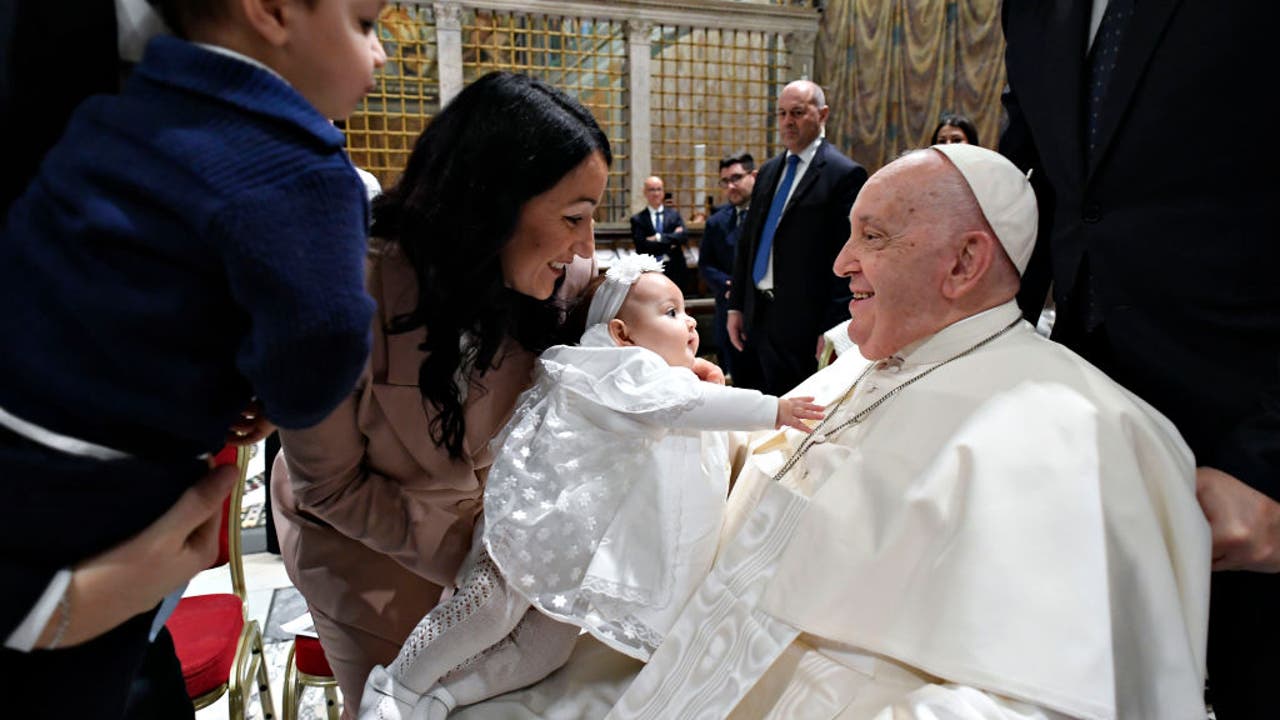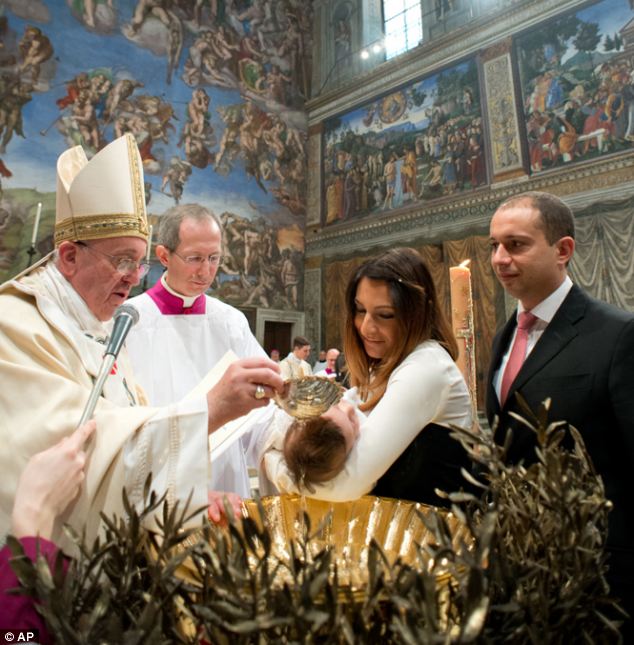Pope Francis Baptizes 21 Vatican Employees' Infants In Sistine Chapel
Hey there, history buffs and religion enthusiasts! Gather 'round because today, we’re diving into a truly spiritual moment that’s got the whole world talking. Pope Francis recently baptized 21 infants of Vatican employees in the iconic Sistine Chapel. This event is more than just a religious ceremony; it’s a reflection of faith, tradition, and the heart of the Catholic Church. So, buckle up, because we’re about to unpack this monumental event in detail.
Now, you might be wondering, why is this such a big deal? Well, for starters, it’s not every day that the leader of the Catholic Church performs baptisms in one of the most sacred places on Earth. The Sistine Chapel isn’t just any old building; it’s a symbol of art, faith, and centuries of religious history. And when Pope Francis steps into that space, it’s like stepping into a time capsule of spiritual significance.
Before we dive deep into the details, let’s set the scene. Imagine the frescoes of Michelangelo surrounding you as the Pope gently pours holy water over the heads of 21 little ones. It’s a blend of ancient tradition and modern spirituality, all happening under the watchful eyes of Vatican employees and their families. This is more than just a baptism; it’s a celebration of faith, family, and community. Ready to learn more? Let’s go!
Read also:Medjugorje Pope Francis A Closer Look At The Spiritual Phenomenon
Understanding the Event: Pope Francis Baptizes in the Sistine Chapel
First things first, let’s break down what exactly happened. On this special day, Pope Francis gathered in the Sistine Chapel to perform the sacred rite of baptism for 21 infants. These weren’t just any babies; they belonged to Vatican employees, a gesture that highlights the Pope’s commitment to serving not just the global Catholic community but also the people who work within the Vatican itself.
This event wasn’t just about religion; it was about community. The Sistine Chapel, with its breathtaking artwork and historical significance, became the backdrop for a deeply personal and spiritual moment for these families. It’s like the Pope said, “Hey, I see you, and I want to celebrate your faith journey with you.” Talk about a powerful message!
Why the Sistine Chapel?
You might be asking, why the Sistine Chapel? Why not the Vatican Basilica or some other holy site? Well, the Sistine Chapel holds a special place in the heart of the Catholic Church. It’s where popes are elected, where some of the most important religious ceremonies take place, and where Michelangelo’s masterpieces adorn the walls and ceiling.
Pope Francis chose this location for a reason. It’s a place that embodies the beauty and depth of Catholic tradition. By performing the baptisms here, he’s reinforcing the idea that faith is not just about rituals; it’s about connecting with something greater in a space that inspires awe and reverence.
The Significance of Baptism in the Catholic Church
Before we move on, let’s talk about the importance of baptism in the Catholic faith. Baptism is one of the seven sacraments, and it’s considered the gateway to Christian life. It’s a symbol of purification, renewal, and the beginning of a spiritual journey. When Pope Francis performs these baptisms, he’s not just conducting a ceremony; he’s welcoming these infants into the fold of the Church.
For the families involved, this is a life-changing moment. It’s a chance to publicly declare their faith and commit to raising their children in the teachings of the Catholic Church. And with Pope Francis leading the ceremony, it’s like having a spiritual rock star guide you through one of life’s most important milestones.
Read also:Pope Francis Weighs In On Trumps Immigration Pledges A Closer Look At The Intersection Of Faith And Politics
What Does Baptism Symbolize?
Baptism is more than just a religious ritual; it’s a deeply symbolic act. It represents the washing away of original sin, the cleansing of the soul, and the beginning of a new life in Christ. When Pope Francis pours holy water over the heads of these infants, he’s not just performing a ceremony; he’s facilitating a spiritual transformation.
Think about it like this: baptism is like hitting the reset button on life. It’s a chance to start fresh, to begin a journey of faith and discovery. And when it’s performed by the Pope himself, it’s like getting a personal invitation to the banquet of eternal life. Who wouldn’t want that?
Pope Francis: A Leader with Heart
Let’s talk about the man behind the ceremony: Pope Francis. This guy isn’t just any pope; he’s a leader who’s redefined what it means to be a spiritual guide in the modern world. Known for his humility, compassion, and progressive views, Pope Francis has captured the hearts of Catholics and non-Catholics alike.
| Name | Pope Francis |
|---|---|
| Birth Name | Jorge Mario Bergoglio |
| Date of Birth | December 17, 1936 |
| Place of Birth | Buenos Aires, Argentina |
| Ordained Priest | December 13, 1969 |
| Elected Pope | March 13, 2013 |
Pope Francis’s approach to leadership is all about inclusivity and compassion. He’s not afraid to challenge the status quo and push for change within the Church. Whether it’s advocating for social justice, environmental stewardship, or reaching out to marginalized communities, Pope Francis is a leader who walks the walk and talks the talk.
His Vision for the Church
Pope Francis envisions a Church that’s more welcoming, more inclusive, and more engaged with the world. He believes that faith isn’t something that should be confined to the walls of a church; it’s something that should be lived out in everyday life. By performing baptisms for the infants of Vatican employees, he’s showing that the Church is not just for the elite; it’s for everyone.
His actions speak louder than words. By choosing to perform these baptisms in the Sistine Chapel, he’s sending a powerful message: faith is about community, and the Church is here to serve all its members, regardless of their status or position.
Tradition Meets Modernity: The Ceremony in Detail
Now, let’s get into the nitty-gritty of the ceremony itself. The baptism of 21 infants in the Sistine Chapel was a carefully orchestrated event that blended ancient tradition with modern sensibilities. Here’s what went down:
- The ceremony began with a prayer led by Pope Francis, setting the tone for the spiritual occasion.
- Each infant was brought forward by their parents, symbolizing the family’s commitment to their child’s faith journey.
- Pope Francis gently poured holy water over the heads of the infants, pronouncing the words of baptism.
- The ceremony concluded with a blessing and a heartfelt message from the Pope to the families.
It was a beautiful blend of solemnity and joy, a reminder that faith is not just about rituals but about relationships. The families present were not just witnesses to a religious ceremony; they were participants in a sacred moment that will stay with them for the rest of their lives.
Symbolic Gestures in the Ceremony
Every detail of the ceremony was carefully chosen to convey a deeper meaning. From the use of holy water to the choice of location, every element was symbolic. Here are a few key gestures that stood out:
- The use of holy water, a symbol of purification and new life.
- The presence of the Sistine Chapel’s frescoes, a reminder of the Church’s rich artistic and spiritual heritage.
- Pope Francis’s personal interaction with the families, a testament to his commitment to serving the community.
These symbolic gestures are more than just ceremony; they’re a way of connecting with something greater, of reminding us that faith is about more than just words and actions; it’s about the heart.
Community and Faith: The Heart of the Vatican
One of the most beautiful aspects of this event is how it highlights the role of community in the Catholic Church. The Vatican isn’t just a place of religious authority; it’s a community of people who work together to serve the Church and its mission. By baptizing the infants of Vatican employees, Pope Francis is acknowledging the importance of these individuals in the life of the Church.
This event is a reminder that faith isn’t something that happens in isolation. It’s something that happens within the context of community. Whether it’s the families present at the ceremony or the Vatican employees who work behind the scenes, everyone plays a role in the life of the Church.
The Role of Vatican Employees
Vatican employees often go unnoticed, but they play a crucial role in the day-to-day operations of the Vatican. From maintaining the buildings to organizing events, these individuals are the backbone of the Church’s administrative and operational functions. By baptizing their infants, Pope Francis is acknowledging their contributions and celebrating their faith journeys.
It’s a powerful message: the Church is not just for the leaders; it’s for everyone. And when the leader of the Church takes the time to celebrate the milestones of ordinary people, it’s a reminder that faith is about more than just hierarchy; it’s about community.
Challenges and Opportunities: The Future of the Church
As we look to the future, it’s important to consider the challenges and opportunities facing the Catholic Church. Pope Francis’s actions, including the baptism of 21 infants in the Sistine Chapel, highlight the Church’s commitment to inclusivity and community. But there are still challenges to be addressed, such as declining attendance at Mass, issues of social justice, and the need for greater transparency within the Church.
Despite these challenges, there are opportunities for growth and renewal. The Church is in a unique position to lead by example, to be a beacon of hope and compassion in a world that often feels divided and uncertain. By embracing modernity while staying true to its traditions, the Church can continue to be a source of inspiration for millions around the world.
Pope Francis’s Vision for the Future
Pope Francis’s vision for the future is one of hope, inclusivity, and action. He believes that the Church has a responsibility to address the pressing issues of our time, from climate change to social inequality. By leading by example, he’s showing that faith isn’t just about words; it’s about actions.
His commitment to serving the marginalized, advocating for social justice, and promoting environmental stewardship is a testament to his belief that the Church has a role to play in shaping a better world. And by performing baptisms for the infants of Vatican employees, he’s reminding us that faith is about more than just rituals; it’s about relationships, community, and a shared commitment to making the world a better place.
Conclusion: A Celebration of Faith and Community
As we wrap up this article, let’s take a moment to reflect on what we’ve learned. Pope Francis’s baptism of 21 infants in the Sistine Chapel is more than just a religious ceremony; it’s a celebration of faith, community, and tradition. It’s a reminder that the Church is not just for the leaders; it’s for everyone.
This event highlights the importance of inclusivity, compassion, and service in the life of the Church. Whether it’s the families present at the ceremony or the Vatican employees who work behind the scenes, everyone plays a role in the life of the Church. And as we look to the future, we’re reminded that faith is about more than just rituals; it’s about relationships, community, and a shared commitment to making the world a better place.
So, what can you do? Leave a comment, share this article with your friends, and join the conversation. Together, we can continue to explore the beauty and depth of faith, and maybe, just maybe, we can make the world a little brighter, one baptism at a time.
Table of Contents
Article Recommendations


